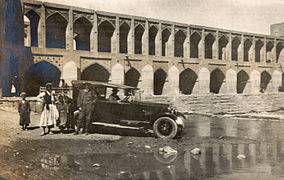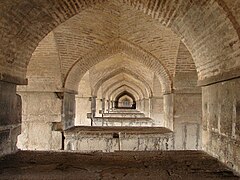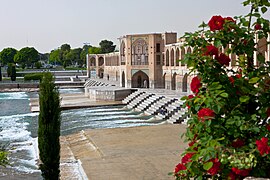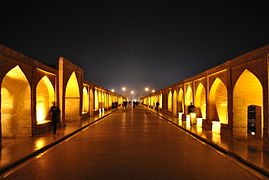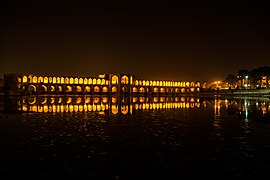Khaju Bridge: Difference between revisions
No edit summary |
|||
| (15 intermediate revisions by 11 users not shown) | |||
| Line 1: | Line 1: | ||
{{Short description|Bridge in Isfahan, Iran}} |
|||
{{Infobox bridge |
{{Infobox bridge |
||
|bridge_name = Khaju Bridge |
|bridge_name = Khaju Bridge |
||
| Line 13: | Line 14: | ||
|begin = |
|begin = |
||
|complete = 1650 |
|complete = 1650 |
||
|coordinates = {{ |
| coordinates = {{WikidataCoord|display=it}} |
||
| |
| mapframe-zoom = 15 |
||
}} |
}} |
||
The '''Khaju Bridge''' ({{ |
The '''Khaju Bridge''' ({{langx|fa|پل خواجو}}, {{transliteration|fa|Pol-e Xāju}}) is one of the historical [[bridge]]s on the [[Zayanderud]], the largest river of the [[Iranian Plateau]], in [[Isfahan]], [[Iran]]. Serving as both a bridge and a [[weir]], it links the Khaju quarter on the north bank with the [[Zoroastrianism|Zoroastrian]] quarter across the Zayanderud. It is located at the end of Kamal Ismail Street in Isfahan.<ref>Isfahan book (Lotfollah Honarfar), 1977, pocket books company, page 98</ref> |
||
The mausoleum of [[Arthur Upham Pope|Arthur Pope]] and his wife Phyllis Ackerman is situated nearby. |
|||
The bridge served a primary function as a building and a place for public meetings in the past.<ref>{{cite book |title=Developments in Structural Form |first=Rowland J. |last=Mainstone |publisher=Architectural Press |url=https://books.google.com/books?id=7fpSAAAAMAAJ |year=1998 |page=261}}</ref><ref name="andrew"/> It has been described as the city's finest bridge.<ref name="andrew">{{cite book |title=Iran |first1=Andrew |last1=Burke |first2=Mark |last2=Elliot |publisher=Lonely Planet |year=2008 |page=243 |url=https://books.google.com/books?id=gEca_4iSNCUC}}</ref> |
|||
Persian art historians and revivalists, [[Arthur Upham Pope]] and [[Phyllis Ackerman]] are interred in a mausoleum nearby.<ref>{{Cite news|last=Erdbrink|first=Thomas|date=2014-04-14|title=American’s Wish for Iranian Burial Riles Hard-Liners|language=en-US|work=The New York Times|url=https://www.nytimes.com/2014/04/14/world/middleeast/americans-wish-for-iranian-burial-riles-hard-liners.html|access-date=2021-09-10|issn=0362-4331}}</ref> |
|||
==History== |
==History== |
||
| Line 23: | Line 27: | ||
In words of [[Arthur Upham Pope|Arthur Pope]] and [[Jean Chardin]], Khaju is "the culminating monument of Persian bridge architecture and one of the most interesting bridges extant ... where the whole has rhythm and dignity and combines in the happiest consistency, utility, beauty, and recreation."<ref>{{cite book |title=A Journey to Persia: Jean Chardin's portrait of a seventeenth-century empire |author=Sir John Chardin, Ronald W. Ferrier |publisher=I.B.Tauris |year=1996 |pages=149 |url=https://books.google.com/books?id=5CLkDgmVs1QC}}</ref> |
In words of [[Arthur Upham Pope|Arthur Pope]] and [[Jean Chardin]], Khaju is "the culminating monument of Persian bridge architecture and one of the most interesting bridges extant ... where the whole has rhythm and dignity and combines in the happiest consistency, utility, beauty, and recreation."<ref>{{cite book |title=A Journey to Persia: Jean Chardin's portrait of a seventeenth-century empire |author=Sir John Chardin, Ronald W. Ferrier |publisher=I.B.Tauris |year=1996 |pages=149 |url=https://books.google.com/books?id=5CLkDgmVs1QC}}</ref> |
||
The poets of Isfahan wrote beautiful poems on the Khajoo bridge and in these poems they praised its beauties. Among these poems is the long poem by Saeb Tabrizi which describes one of the days of celebration and illumination next to this bridge. According to historians and scholars who have studied the Safavid dynasty, Shah Abbas II's goal in building the Khajoo Bridge was to connect the two districts of Khajoo and the Hassanabad Gate with Takht-e Folad and Shiraz Road. Tourists who came to Isfahan at different times praised the beauty of the Khajoo Bridge and considered it one of the eternal masterpieces of Iranian and Islamic architecture.<ref>Isfahan website, 2021</ref> |
|||
==Structure== |
==Structure== |
||
The bridge has 23 arches |
The bridge has 23 arches and is 133 meters long and 12 meters wide. Iranian architects have raised concerns about damage inflicted on the bridge during recent "improvement program" renovations, citing, among other problems, the destruction of the original stepped base of the bridge, the alterations made to the riverbed, and the removal of the Safavid inscribed stone blocks from the bridge.<ref>{{cite web |title= |
||
There are several [[sluice gate]]s under the archways, through which the water flow of the [[Zayanderud]] is regulated. When the sluice gates are closed, the water level behind the bridge is raised to facilitate the irrigation of the many gardens along the river upstream of the bridge. On the upper level of the bridge, the main central aisle was utilized by horses and carts and the vaulted paths on either side by pedestrians. Octagonal [[pavilion]]s in the center of the bridge on both the down and the upstream sides provide vantage points for the remarkable views. The lower level of the bridge may be accessed by pedestrians and remains a popular shady place for relaxing. |
|||
Iranian architects have raised concerns about damage inflicted on the bridge during recent "improvement program" renovations, citing, among other problems, the destruction of the original stepped base of the bridge, the alterations made to the riverbed, and the removal of the Safavid inscribed stone blocks from the bridge.<ref>{{cite web |title= |
|||
Critiquing Recent Renovations of the Khaju Bridge in Esfahan, Iran |first=Mehrdad |last=Parsipour |publisher=Green Prophet |date=20 July 2010 |access-date=21 March 2011 |url=http://www.greenprophet.com/2010/07/20/24580/the-recent-renovations-of-khajoo-bridge-in-esfahan-and-criticisms}}</ref><ref>{{cite web |title='Restoration' damages at Pole Khaju in Isfahan |url=http://kavehfarrokh.com/articles/endangered-archaeological-sites/restoration-damages-at-pole-khaju-in-isfahan |first=Kaveh |last=Farrokh}}</ref> |
Critiquing Recent Renovations of the Khaju Bridge in Esfahan, Iran |first=Mehrdad |last=Parsipour |publisher=Green Prophet |date=20 July 2010 |access-date=21 March 2011 |url=http://www.greenprophet.com/2010/07/20/24580/the-recent-renovations-of-khajoo-bridge-in-esfahan-and-criticisms}}</ref><ref>{{cite web |title='Restoration' damages at Pole Khaju in Isfahan |url=http://kavehfarrokh.com/articles/endangered-archaeological-sites/restoration-damages-at-pole-khaju-in-isfahan |first=Kaveh |last=Farrokh}}</ref> |
||
==Gallery== |
==Gallery== |
||
<gallery mode="packed"> |
<gallery mode="packed"> |
||
Bridge Khjoou by Eugène Flandin.jpg|The Khaju Bridge as depicted by [[Eugène Flandin]] in 1840 |
Bridge Khjoou by Eugène Flandin.jpg|The Khaju Bridge as depicted by [[Eugène Flandin]] in 1840 |
||
Isfahan R04.jpg|The Khaju Bridge in the early 20th century |
Isfahan R04.jpg|The Khaju Bridge in the early 20th century |
||
Iran - Isfahan - Khajoo Bridge.jpg|A view of the Khaju Bridge in January 2010 |
Iran - Isfahan - Khajoo Bridge.jpg|A view of the Khaju Bridge in January 2010 |
||
Isfahan - Khajoo Bridge ^ Stony Lion - panoramio.jpg|One of the two stone lions of the Khaju Bridge |
Isfahan - Khajoo Bridge ^ Stony Lion - panoramio.jpg|One of the two stone lions of the Khaju Bridge |
||
Under bridge.JPG|Arches under the Khaju Bridge |
Under bridge.JPG|Arches under the Khaju Bridge |
||
Pol e Khajoo - panoramio.jpg|A view seen from within the Khaju Bridge |
Pol e Khajoo - panoramio.jpg|A view seen from within the Khaju Bridge |
||
Khaju Bridge - Isfahan-Iran-ninara09.jpg|A view of the Khaju Bridge in April 2012 |
Khaju Bridge - Isfahan-Iran-ninara09.jpg|A view of the Khaju Bridge in April 2012 |
||
Dawn of the khajoo bridge 1.jpg|A view of the bridge and the [[Zayanderud]] at sunset |
Dawn of the khajoo bridge 1.jpg|A view of the bridge and the [[Zayanderud]] at sunset |
||
Khaju Bridge.JPG|A view of the walkway on the Khaju Bridge at night |
Khaju Bridge.JPG|A view of the walkway on the Khaju Bridge at night |
||
Khaju - Bridge.jpg|A wide view of the Khaju Bridge at night |
Khaju - Bridge.jpg|A wide view of the Khaju Bridge at night |
||
</gallery> |
</gallery> |
||
| Line 51: | Line 52: | ||
==References== |
==References== |
||
{{ |
{{Reflist}} |
||
==Further reading== |
==Further reading== |
||
Latest revision as of 03:37, 29 October 2024
Khaju Bridge | |
|---|---|
 | |
| Coordinates | 32°38′12″N 51°41′0″E / 32.63667°N 51.68333°E |
| Crosses | Zayanderud |
| Locale | Isfahan, Iran |
| Characteristics | |
| Design | Arch bridge |
| Material | Stone and brick |
| Total length | 137 m (449 ft) |
| Width | 12 m (39 ft) |
| No. of spans | 21 |
| History | |
| Construction end | 1650 |
| Location | |
 | |
The Khaju Bridge (Persian: پل خواجو, Pol-e Xāju) is one of the historical bridges on the Zayanderud, the largest river of the Iranian Plateau, in Isfahan, Iran. Serving as both a bridge and a weir, it links the Khaju quarter on the north bank with the Zoroastrian quarter across the Zayanderud. It is located at the end of Kamal Ismail Street in Isfahan.[1]
The bridge served a primary function as a building and a place for public meetings in the past.[2][3] It has been described as the city's finest bridge.[3]
Persian art historians and revivalists, Arthur Upham Pope and Phyllis Ackerman are interred in a mausoleum nearby.[4]
History
[edit]The Khaju Bridge was built around 1650, under the reign of Abbas II, the seventh Safavid king (shah) of Iran, on the foundations of an older bridge. The existing inscriptions suggest that the bridge was repaired in 1873. There is a pavilion located in the center of the structure, inside which Abbas II would have once sat, admiring the view.[3] Today, remnants of a stone seat is all that is left of the king's chair.
In words of Arthur Pope and Jean Chardin, Khaju is "the culminating monument of Persian bridge architecture and one of the most interesting bridges extant ... where the whole has rhythm and dignity and combines in the happiest consistency, utility, beauty, and recreation."[5] The poets of Isfahan wrote beautiful poems on the Khajoo bridge and in these poems they praised its beauties. Among these poems is the long poem by Saeb Tabrizi which describes one of the days of celebration and illumination next to this bridge. According to historians and scholars who have studied the Safavid dynasty, Shah Abbas II's goal in building the Khajoo Bridge was to connect the two districts of Khajoo and the Hassanabad Gate with Takht-e Folad and Shiraz Road. Tourists who came to Isfahan at different times praised the beauty of the Khajoo Bridge and considered it one of the eternal masterpieces of Iranian and Islamic architecture.[6]
Structure
[edit]The bridge has 23 arches and is 133 meters long and 12 meters wide. Iranian architects have raised concerns about damage inflicted on the bridge during recent "improvement program" renovations, citing, among other problems, the destruction of the original stepped base of the bridge, the alterations made to the riverbed, and the removal of the Safavid inscribed stone blocks from the bridge.[7][8]
Gallery
[edit]-
The Khaju Bridge as depicted by Eugène Flandin in 1840
-
The Khaju Bridge in the early 20th century
-
A view of the Khaju Bridge in January 2010
-
One of the two stone lions of the Khaju Bridge
-
Arches under the Khaju Bridge
-
A view seen from within the Khaju Bridge
-
A view of the Khaju Bridge in April 2012
-
A view of the bridge and the Zayanderud at sunset
-
A view of the walkway on the Khaju Bridge at night
-
A wide view of the Khaju Bridge at night
See also
[edit]- Si-o-se-pol, another such bridge on the same river
- Putra Bridge, a bridge in Malaysia that was inspired by Khaju
References
[edit]- ^ Isfahan book (Lotfollah Honarfar), 1977, pocket books company, page 98
- ^ Mainstone, Rowland J. (1998). Developments in Structural Form. Architectural Press. p. 261.
- ^ a b c Burke, Andrew; Elliot, Mark (2008). Iran. Lonely Planet. p. 243.
- ^ Erdbrink, Thomas (2014-04-14). "American's Wish for Iranian Burial Riles Hard-Liners". The New York Times. ISSN 0362-4331. Retrieved 2021-09-10.
- ^ Sir John Chardin, Ronald W. Ferrier (1996). A Journey to Persia: Jean Chardin's portrait of a seventeenth-century empire. I.B.Tauris. p. 149.
- ^ Isfahan website, 2021
- ^ Parsipour, Mehrdad (20 July 2010). "Critiquing Recent Renovations of the Khaju Bridge in Esfahan, Iran". Green Prophet. Retrieved 21 March 2011.
- ^ Farrokh, Kaveh. "'Restoration' damages at Pole Khaju in Isfahan".
Further reading
[edit]- Blair, Sheila S.; Bloom, Jonathan M. (1994). The Art and Architecture of Islam. New Haven: Yale University Press.
- Michell, George (1978). Architecture of the Islamic World. London: Thames and Hudson.


